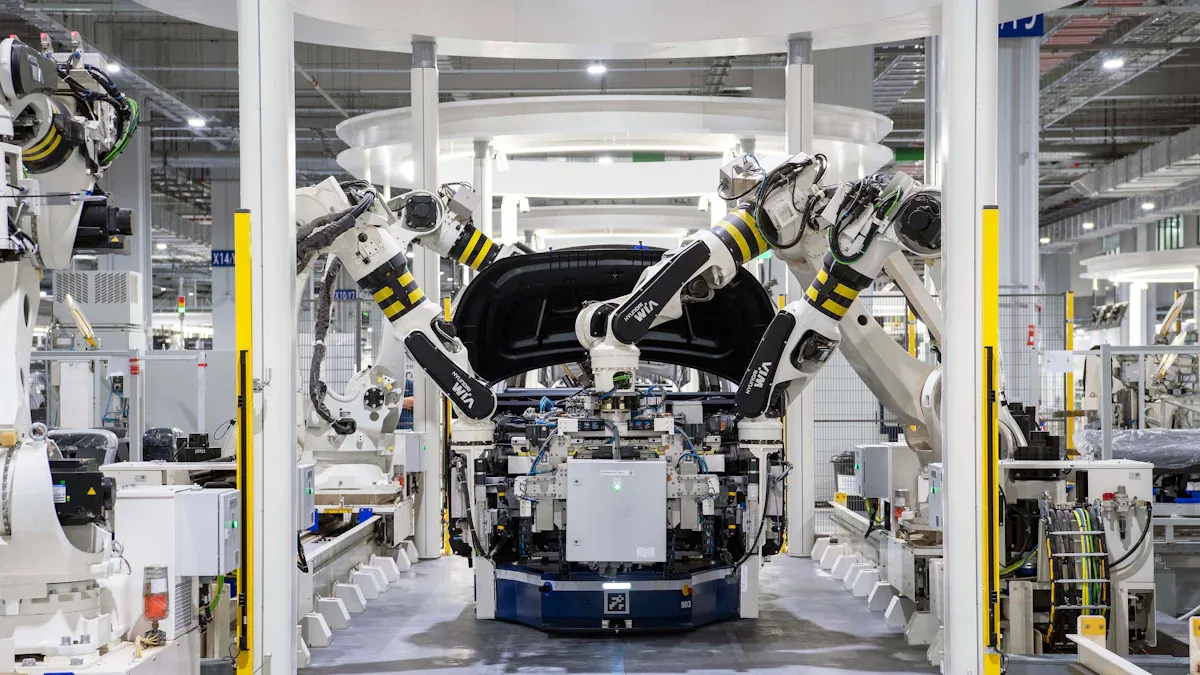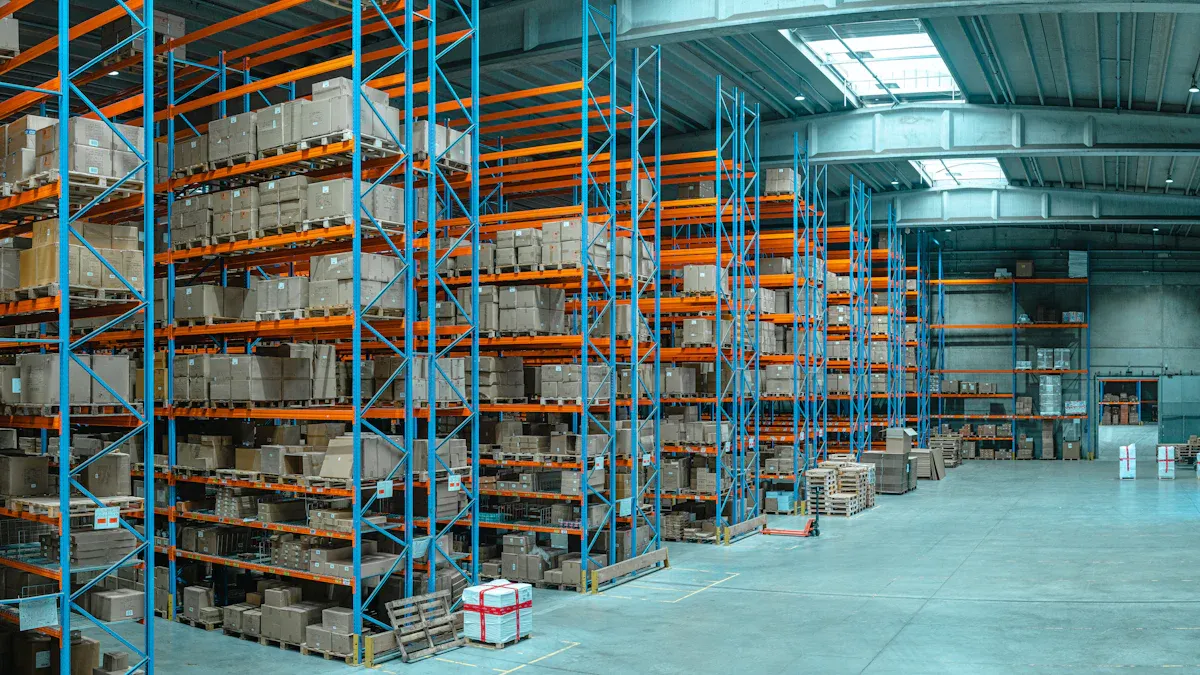What Are Modern Industrial Supply Chain Systems in Manufacturing

Modern industrial supply chain systems in manufacturing help you connect every step, from raw materials to product delivery. You use strategic coordination to optimize how things move and work together. Real-time visibility and integration let you track inventory, production, and transport. You can make better decisions, avoid stockouts, and improve delivery times. Recent studies show these systems help you:
Reduce costs and waste by managing bottlenecks.
Monitor inventory for timely replenishments.
Boost customer satisfaction with faster deliveries.
Cut carbon emissions by optimizing transport routes.
Respond quickly to disruptions and allocate resources more effectively.
These systems increase your efficiency, resilience, and sustainability.
Key Takeaways
Modern supply chain systems connect every step of manufacturing, from raw materials to delivery, ensuring smooth operations.
Real-time visibility and integration allow you to track inventory and production, helping you make informed decisions and improve efficiency.
Implementing lean practices helps reduce waste and costs, enabling your supply chain to respond quickly to customer needs.
Utilizing technology like automation and IoT enhances productivity and visibility, making your supply chain more reliable.
Building strong relationships with suppliers and focusing on sustainability can improve your brand reputation and reduce risks.
Modern Industrial Supply Chain Systems Overview
Core Functions and Structure
You rely on modern industrial supply chain systems to connect every part of your manufacturing process. These systems guide your production and delivery through strategic coordination and optimization. You use them to make sure each step works together smoothly, from sourcing raw materials to delivering finished products.
Tip: An integrated supply chain helps you adapt quickly to changes in customer demand and ensures products arrive on time.
The main functions of modern industrial supply chain systems include:
Procurement: You source and acquire raw materials, components, and services needed for manufacturing.
Production Planning & Scheduling: You plan and manage production activities to match demand forecasts and available resources.
Inventory Management: You balance supply and demand by managing raw materials, work-in-progress, and finished goods.
Logistics & Distribution: You handle transportation, warehousing, and distribution of goods across the global supply chain.
Your supply chain structure covers several key processes:
Raw materials procurement
Production
Quality control
Distribution
Post-sales service
You create an effective supply chain by integrating these processes. You avoid siloed operations and build a system that responds quickly to market changes.
Benefits of Modern Industrial Supply Chain Systems
When you use modern industrial supply chain systems, you see measurable improvements in your manufacturing operations. These systems help you deliver products on time, reduce waste, and improve quality. You also respond faster to customer complaints and maintain high standards with regular supplier assessments.
Benefit | Description |
|---|---|
On-time delivery | Improved scheduling and logistics lead to timely deliveries to customers. |
Reduced scrap rates | Better quality control reduces waste and rework at suppliers. |
Enhanced product quality | Final products meet higher standards as assessed by end customers. |
Faster complaint resolution | Streamlined processes allow for quicker responses to customer complaints. |
Supplier quality assessments | Regular evaluations help maintain high standards and identify potential issues early. |
Higher efficiency rate | Real-time data on materials and delays enables proactive management and backup plans. |
Improved cash flow | Working with reliable suppliers leads to fewer disruptions and quicker invoicing. |
Risk mitigation | Analyzing supply chain data helps identify risks and implement backup plans to avoid disruptions. |
You also build resilience and sustainability into your supply chain. Digital supply chain technologies give you real-time connections with suppliers. You use digital twins to create virtual models of your supply chain, which helps you find alternative suppliers and reduce risks. Investments in digital technologies improve your visibility and relationships with stakeholders.
Effective inventory management helps you build resilience.
Nearly half of companies now hold more inventory to protect against disruptions.
Many manufacturers diversify sourcing strategies to reduce risk.
On-hand inventory acts as a buffer when supply problems occur.
Modern industrial supply chain systems give you the tools to manage risks, improve efficiency, and support sustainable growth.
Key Components of the Manufacturing Supply Chain

Modern industrial supply chain systems help you manage every step from raw materials to finished products. You need to understand how each part works together to keep your manufacturing process running smoothly.
Procurement and Supplier Management
You start by sourcing the materials and components you need. Procurement means finding reliable suppliers and making sure they deliver on time. You use demand forecasting to plan what you need and when. Centralizing data helps you choose the best suppliers and set clear cost targets. You look beyond price and check quality and delivery performance. Building strong relationships with suppliers lets you manage risks together.
Evaluation Technique | Description | Benefit |
|---|---|---|
Advanced Analytics | Use AI to assess reliability and cost-effectiveness. | Fewer disruptions, better delivery rates |
Quality Assessment | Measure supplier quality with Six Sigma. | Consistent products, happier customers |
Cost Analysis | Check all costs with Total Cost of Ownership models. | Save money on procurement |
Sustainability Practices | Review suppliers’ green practices. | Lower carbon footprint |
Delivery Performance | Track On-Time In-Full delivery metrics. | Reliable supply, meets expectations |
Tip: Segment your suppliers by category and monitor their performance to make smarter sourcing decisions.
Production and Inventory
Once you have your materials, you move to production. You plan what to make and when, using systems that match demand with supply. Skilled workers and the right equipment turn raw materials into finished goods. You use inventory strategies like just-in-time, FIFO, and cycle counting to keep stock levels balanced.
Strategy | Description |
|---|---|
Just-in-time (JIT) | Keep only enough stock to meet demand |
First in, first out (FIFO) | Use oldest inventory first |
Economic order quantity (EOQ) | Order the ideal amount to balance costs |
Cloud-based inventory | Track stock in real time with digital tools |
You align your production planning with sales and operations to improve efficiency. You use technology to connect every part of your supply chain, making sure nothing gets missed.
Manufacturing connects suppliers to customers by turning raw materials into finished goods.
Distribution and Logistics
After production, you need to deliver products to your customers. You choose the best distribution model for your business. Direct distribution gives you control and speed, while indirect distribution helps you reach more customers. Centralized warehousing lowers costs, but decentralized warehousing gets products to customers faster.
Optimized distribution planning reduces transportation costs.
Streamlined movement of goods minimizes delays.
You use logistics software to track shipments and manage returns. You plan routes to cut costs and meet customer expectations.
Proactive planning and fast deliveries help you respond to changes in demand and keep your customers happy.
Technology Integration

Real-Time Visibility and Analytics
You use technology to see every part of your supply chain as it happens. Real-time visibility platforms help you track shipments, monitor supplier performance, and get alerts about problems. These platforms give you updates at each stage, from shipping to delivery. You can improve product fulfillment and make sure lead times are accurate. Predictive analytics and machine learning help you spot disruptions before they happen. You analyze historical data and current activity to respond quickly to changes.
Benefit | Description |
|---|---|
You identify issues early and respond fast. | |
Improved Supplier Performance | You track key metrics and find ways to improve. |
Enhanced Cost Savings | You use data to make smart sourcing decisions and save money. |
Tip: Real-time analytics turn scattered data into focused insights, helping you allocate resources better.
Automation and IoT
Automation makes your supply chain faster and more reliable. You use inventory management systems to track stock and forecast demand. Robotic process automation streamlines tasks like procurement and order processing. Automation tools help you work with vendors and keep your supply network strong. The Internet of Things (IoT) connects devices and sensors across your supply chain. Smart shelves tell you when stock is low. IoT-enabled containers monitor temperature for sensitive products. You track components and shipments worldwide.
Automation boosts productivity and efficiency.
IoT improves visibility, lowers costs, and helps you meet customer needs.
Machine learning algorithms learn from data to predict demand and spot disruptions.
Digital Collaboration Platforms
You connect with partners using digital collaboration platforms. These platforms break down silos and let you share information easily. Real-time communication helps you solve problems faster. You align processes with suppliers and respond quickly to demand changes. Multi-enterprise networks, digital twins, and supply chain command centers support seamless collaboration. You use forecasting tools to see production lines and adjust plans. Digital platforms increase resilience and help you make smarter decisions.
Faster response to changes and issues
Greater alignment among partners
Note: Digital collaboration platforms replace manual processes with automated ones, making your supply chain more efficient.
Modern industrial supply chain systems rely on these technologies to keep your operations running smoothly and help you stay competitive.
Challenges and Solutions
Data Management and Security
You face many data management and security challenges in manufacturing supply chains. Different vendors use different systems, which creates security gaps. More partners mean more entry points for hackers. Employees or third-party partners can cause data breaches, sometimes by accident. You must also follow many data protection laws in different countries. Sharing too much information can expose sensitive data.
Expanded attack surfaces from more partners
Insider threats from employees or partners
Regulatory compliance hurdles
Overexposure of sensitive data
To protect your supply chain, you should:
Use data encryption to keep information safe.
Create an incident response plan for quick action.
Test your security with penetration testing.
Tip: Add strong cybersecurity rules to vendor contracts and check suppliers often.
Risk and Resilience
You need to manage risks to keep your supply chain strong. Start by checking new suppliers for problems like sanctions or corruption. Watch suppliers for red flags and build risk profiles. Use a risk-based approach to spot, assess, and fix risks.
Step | Action |
|---|---|
Identify Risk | Use SWOT or FMEA to find weak spots |
Assess Risk | Rank risks by likelihood and impact |
Integrate Management | Align plans with risk priorities |
Mitigate Risk | Take steps to reduce or remove risks |
Monitor & Review | Watch for new risks and update plans |
You can build resilience by:
Stress testing your supply chain to find weak points.
Using multiple suppliers to avoid shortages.
Keeping extra inventory as a buffer.
Sourcing materials closer to your customers.
Note: Mapping your supply chain and using technology for real-time tracking helps you spot risks early.
Sustainability Initiatives
You can make your supply chain more sustainable by using better product design and digital technology. Choose materials that last longer and use renewable resources. Monitor your resource use and connect with partners online. Companies like Unilever have cut greenhouse gas emissions and use renewable electricity.
Product design for longer use
Digital tools for resource tracking
Regenerative processes for renewable materials
Carbon footprint reduction
AI and blockchain for transparency
Many companies improve their market position and brand strength with strong ESG programs. Customers prefer businesses that care about the environment. Sustainable practices also lower costs and attract new partners.
Tip: Sustainability helps you control risks, save money, and build a better reputation.
Optimization & Trends
Lean Practices
You can boost your supply chain performance by using lean practices. Lean methods help you spot and remove waste in your process. You create a smooth flow of materials and information. This approach lowers costs and improves how your supply chain works. You use value stream mapping to see each step in production. This tool helps you find activities that do not add value. You can then remove these steps to make your process faster.
Lean production systems keep materials moving and cut down on delays.
Continuous flow reduces bottlenecks and shortens lead times.
Pull systems help you avoid extra inventory and overproduction.
Tip: Lean practices let you respond quickly to customer needs and keep your supply chain flexible.
Continuous Improvement
You drive supply chain success by focusing on continuous improvement. This method means you always look for ways to make your process better. You involve your team in finding problems and fixing them. You aim to reduce work-in-process inventory and improve how your supply chain runs. You use simple tools to track progress and set goals.
Continuous improvement helps you create efficient production processes.
Employee involvement builds a culture of problem-solving.
Regular reviews help you spot issues early and keep improving.
Note: Small changes add up over time, making your supply chain stronger and more reliable.
Future Innovations
You see new trends shaping supply chain optimization. Companies now use generative AI for demand forecasting and risk management. AI helps with cost negotiation, production planning, and predictive maintenance. You notice a bigger focus on sustainability, with goals to cut Scope 3 emissions. Agile supply chain strategies make your business more responsive to market changes. You see more autonomous supply chains using RPA, AI, and IoT for better efficiency. Cybersecurity investments protect your supply chain from threats. Digital transformation drives innovation and builds resilience.
Generative AI improves planning and forecasting.
Sustainability efforts meet customer and regulatory demands.
Agile strategies help you adapt to change.
Autonomous supply chains use smart technology for speed and accuracy.
Strong cybersecurity keeps your data safe.
🚀 Innovation helps you stay ahead and build a supply chain that can handle future challenges.
You gain many benefits when you use strong supply chain systems in manufacturing. You improve efficiency and keep your business running even when problems happen. Technology helps you track products and make smart choices. Strategic management lets you plan for the future and reach your goals. Stay alert to new trends and keep improving your supply chain. This approach helps you stay ahead in a changing world.
FAQ
What is a supply chain system in manufacturing?
You use a supply chain system to manage how materials move from suppliers to your factory and then to customers. This system helps you organize, track, and deliver products efficiently.
How does technology improve your supply chain?
You use technology to see real-time data, automate tasks, and connect with partners. Digital tools help you spot problems early and make faster decisions.
Why is supplier management important?
You choose reliable suppliers to get quality materials on time. Good supplier management helps you avoid delays, reduce costs, and keep your customers happy.
What is lean manufacturing in supply chains?
You use lean manufacturing to remove waste and improve flow. Lean practices help you save money, speed up production, and respond quickly to customer needs.
How can you make your supply chain more sustainable?
You pick eco-friendly materials, use energy-saving machines, and work with green suppliers. Sustainable choices help you lower your carbon footprint and build a better reputation.
See Also
Simplifying Supply Chain Management With American Logistics Solutions
Enhancing Global Efficiency Through Point-to-Point Logistics Systems
Key Strategies For Effective Global Logistics Management
Connecting Warehouses To Optimize Supply Chains With PGL
Efficient Inventory Management And Distribution Through Premier Logistics
